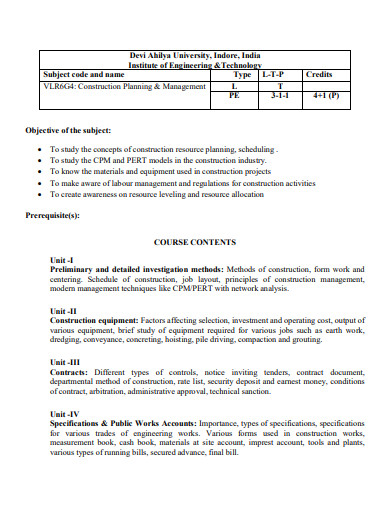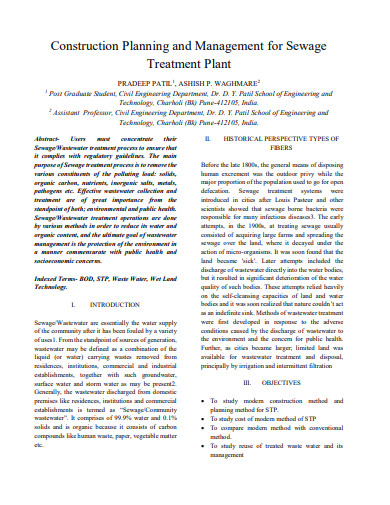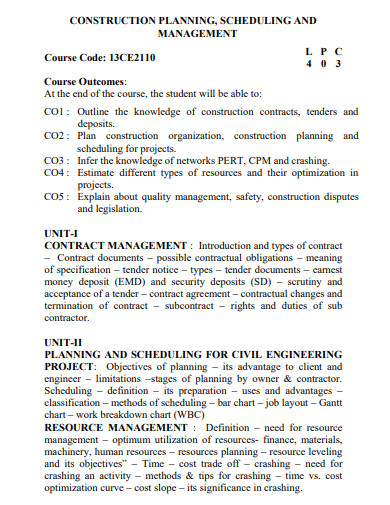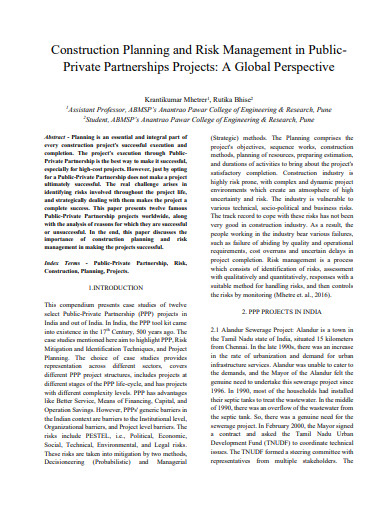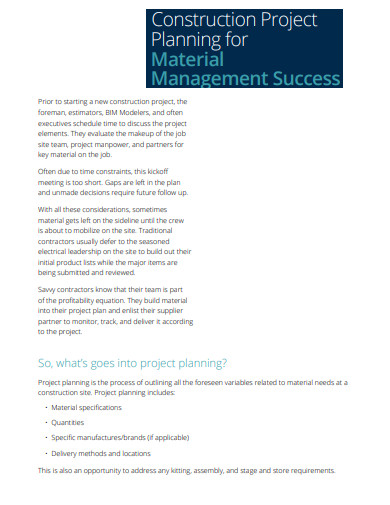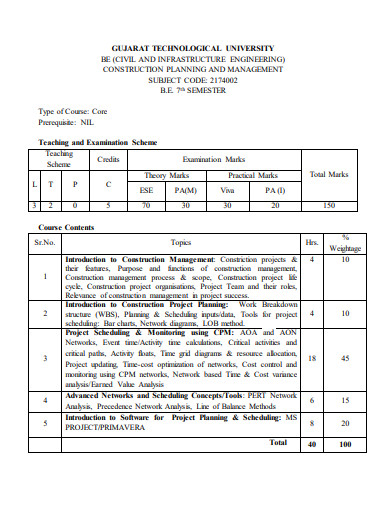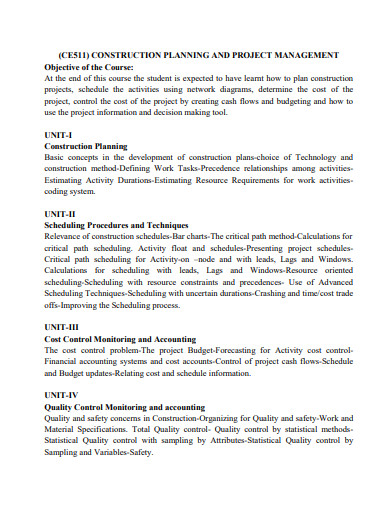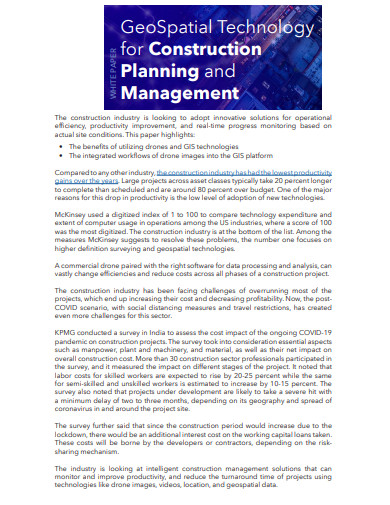In the ever-evolving realm of construction, the significance of meticulous planning and adept management cannot be overstated. Effective construction planning and management harmonize budgetary constraints, sample timeline targets, and quality benchmarks to ensure projects are completed efficiently and to specification. By integrating advanced technologies and proven methodologies, professionals in this domain not only shape skylines but also guarantee safety, sustainability, and stakeholder satisfaction. Dive into the essentials that underpin every successful construction venture.
10+ Construction Planning and Management Samples
1. Basic Construction Management Sample
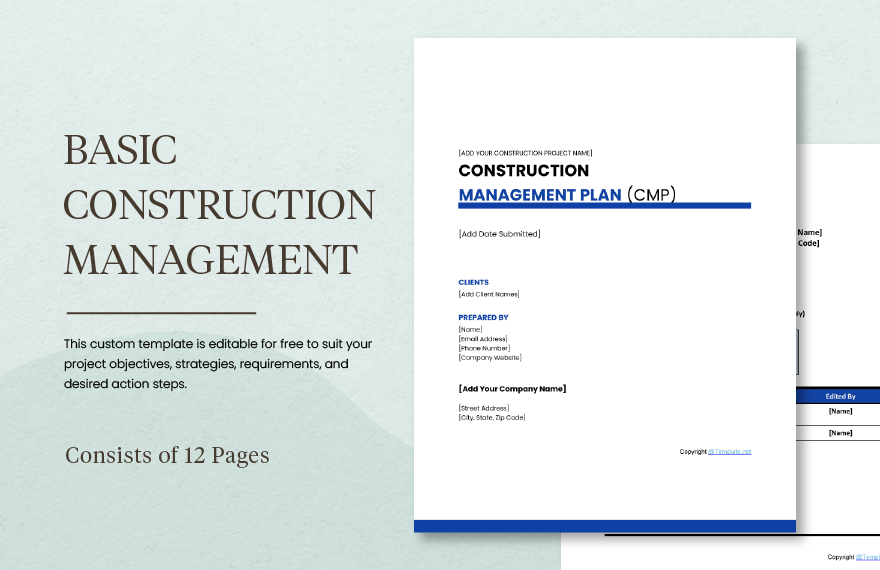
[/ns_col]
[/ns_row]2. Construction Resource Management Plan
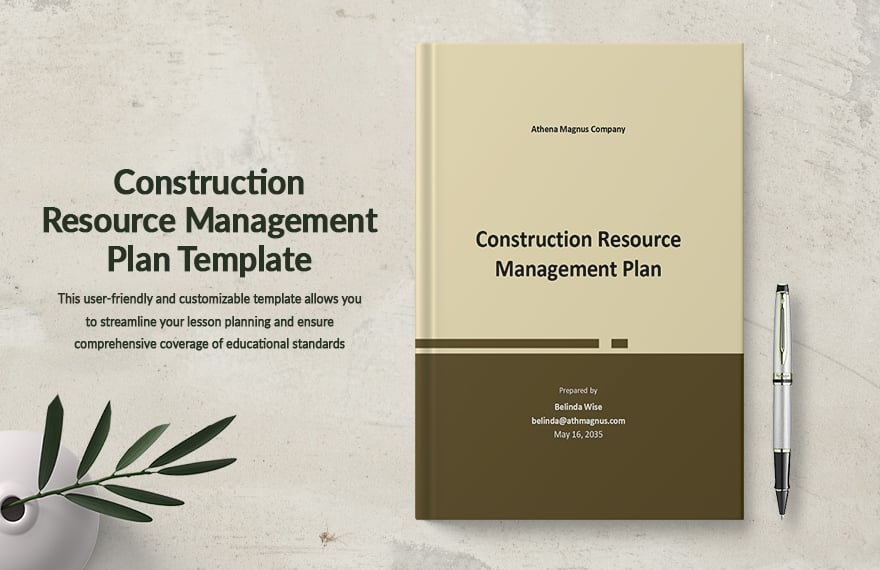
[/ns_col]
[/ns_row]3. Basic Construction Management Sample
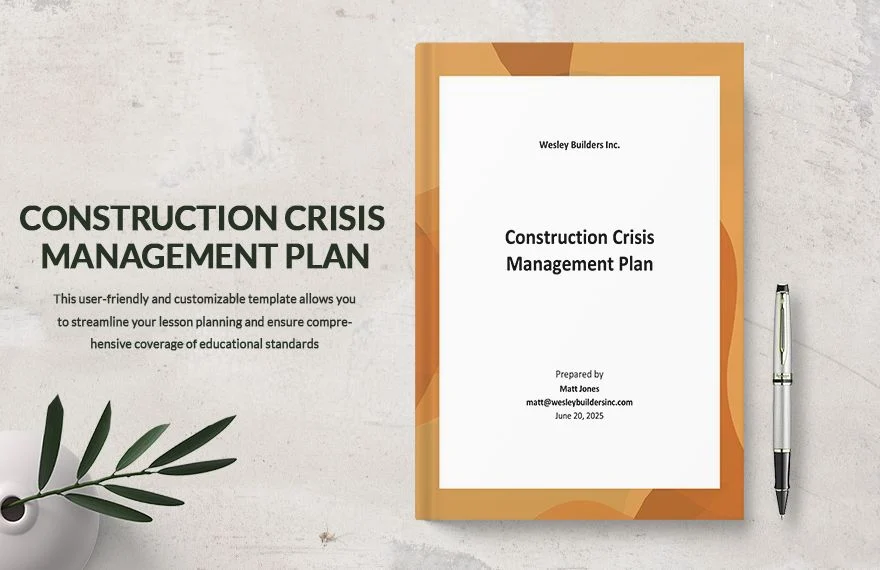
Source[/ns_col]
[/ns_row]4. Basic Construction Planning and Management Template
5. Construction Planning and Management For Sewage Treatment Plant Template
What is Construction Planning and Management? Definition, Types, and Steps
Construction planning and management refer to a systematic approach used in the planning, coordinating, and controlling of a construction project from its conception to completion. This process ensures that the project is finished within the stipulated time, adhering to quality standards and within the estimated budget. The primary aim is to optimize the integration of various resources, including manpower, materials, machinery, and methodologies, to ensure the smooth and efficient execution of any construction task.
Types of Construction Planning
Strategic Planning: This is a long-term planning that usually spans years or decades. It involves defining the strategic objectives and mapping out the pathways to achieve them. Large infrastructure projects, town planning, and urban development usually fall under this category.
Operational Planning: Operational planning is short-term, focusing on specific tasks or activities for a short duration, which may be weeks or months. It deals with resource allocation, scheduling, and monitoring of specific tasks in a construction project.
Tactical Planning: Sitting between strategic and operational planning, tactical planning bridges the long-term objectives with short-term activities. It may cover periods from a few months to a couple of years and includes deciding on methodologies, resource optimization, and risk management.
Steps in Construction Planning and Management
Initiation and Conception: This is the foundational step where the project idea is birthed. It involves identifying the need for a project, preliminary assessments, and basic feasibility checks.
Planning and Design: This phase requires meticulous detailing. It includes drafting blueprints, deciding on the construction methodologies, procurement strategies, resource allocation, and creating a timeline for the project.
Resource Allocation: Critical for any project, this step involves identifying and assigning the necessary resources like labor, machinery, materials, and finance. Ensuring the right resources are available at the right time is pivotal for the project’s success.
Execution: This is the phase where actual construction begins. All the plans are put into action, and the physical structure starts taking shape.
Monitoring and Controlling: Throughout the execution phase, it’s crucial to continuously monitor the project’s progress against the set benchmarks. This ensures the project stays on track and any deviations are corrected promptly.
Completion and Handover: Once the construction is complete, the final checks and inspections are carried out. Once everything is deemed satisfactory, the project is handed over to the client or owner.
Review and Feedback: After the project handover, feedback is collected to understand any shortcomings, lessons learned, and areas of improvement. This step is crucial for continuous learning and improving future projects.
By understanding the intricacies of construction planning and management, stakeholders can better navigate the complexities of the construction world, ensuring successful and efficient project completions. Whether it’s a residential building or a mega infrastructure project, effective planning and management are the backbone of every successful construction venture.
What are the Phases of Construction Management?
Conceptualization and Design Phase
At the heart of any construction project lies its concept and design. This phase primarily focuses on understanding the client’s requirements, vision, and objectives. Preliminary sketches and drafts are prepared by architects, capturing the essence of what the final structure should represent. With the aid of tools like CAD (Computer-Aided Design), the initial ideas transform into formalized blueprints, which will serve as a roadmap for all subsequent stages. Throughout this phase, feasibility studies and environmental impact assessments may also be conducted to ensure the viability of the proposed project.
Preconstruction Phase
Before actual construction begins, a lot of groundwork takes place. This preconstruction stage involves detailed planning and preparations, setting the foundation for a successful project. The construction manager conducts site evaluations, identifies potential challenges, and plans for risk mitigation. Budgets are refined, schedules are plotted, and resources, including labor and materials, are secured. This phase also sees the finalization of contracts, acquisition of permits, and the selection of subcontractors, ensuring that all legal and regulatory boxes are ticked.
Procurement Phase
This phase is dedicated to the acquisition of all necessary materials, equipment, and labor required for the construction project. Effective procurement ensures that high-quality resources are available on time and within budget constraints. From sourcing raw materials to hiring skilled workers and securing the right tools and machinery, this stage lays the tangible groundwork for the actual construction.
Construction Phase
The moment when plans turn to reality – the construction phase is where the actual building takes place. Ground is broken, foundations are laid, and structures begin to rise. Construction managers play a pivotal role during this phase, coordinating tasks, supervising on-site activities, ensuring safety protocols are observed, and making real-time decisions to address unforeseen challenges. This phase also requires regular monitoring and adjustments to ensure alignment with the project’s timeline and budget.
Commissioning and Handover Phase
Upon completion of the construction, the project undergoes rigorous quality checks, inspections, and testing to ensure it adheres to the stipulated standards and requirements. After ensuring the structure’s integrity, functionality, and safety, it is formally commissioned. The handover process involves transferring the project’s ownership from the construction team to the client or stakeholders, accompanied by all relevant documentation, warranties, and operational guidelines.
Post-Construction Review Phase
Every project offers valuable insights and lessons. In the post-construction review, stakeholders gather to assess the project’s success, identifying areas of improvement, challenges faced, and best practices that emerged. This reflective phase not only marks the project’s formal closure but also provides a knowledge base for enhancing the efficiency and success of future endeavors.
6. Simple Construction Planning and Management Template
7. Construction Planning and Risk Management Template
8. Construction Planning For Material Management Success Template
9. Printable Construction Planning and Management Template
10. Construction Planning and Project Management Template
11. Construction Planning and Management in PDF
Why is Construction Planning and Management Important?
Ensuring Cost Efficiency
One of the fundamental reasons construction planning and management is vital is its direct impact on cost efficiency. Proper planning allows for accurate budget forecasts, resource optimization, and a reduction in wastage, ensuring projects are executed within financial constraints.
Mitigating Risks
The construction industry is fraught with potential risks – from unforeseen site challenges to weather-related disruptions and safety hazards. Effective management and preemptive planning help identify these risks early on, allowing for timely interventions and mitigation strategies.
Adherence to Quality Standards
A well-managed construction project ensures that quality standards are consistently met. Through continuous monitoring, evaluations, and checks, construction planning and management ensure the end product aligns with the expectations set during the design phase.
Timely Project Completion
Time overruns can escalate costs and result in contractual breaches. Proper planning, backed by efficient management, ensures that projects are executed within the stipulated timeline, safeguarding stakeholder interests and maintaining contractual obligations.
Safety Assurance
Construction sites can be hazardous zones. Effective management ensures the implementation and adherence to safety protocols, reducing the likelihood of accidents and ensuring the well-being of all on-site workers.
Optimal Resource Utilization
Resources, whether they be materials, machinery, or manpower, are finite. Proper planning ensures they are utilized optimally, minimizing wastage and ensuring every resource serves its purpose effectively.
Client Satisfaction
Ultimately, construction planning and management are pivotal in ensuring client satisfaction. By meeting quality benchmarks, adhering to timelines, and staying within budgetary constraints, projects are more likely to align with clients’ visions and expectations, leading to better relationships and future collaborations.
In summary, construction planning and management are not just auxiliary processes; they are fundamental pillars that determine the success of any construction venture. With challenges aplenty in the construction domain, efficient planning and robust management become the bedrock on which successful projects are built.
How To Create Construction Planning and Management?
The first step to creating a robust construction plan and management strategy is to gain a deep understanding of the project’s scope. This encompasses knowing the client’s needs, assessing the scale of the project, and identifying specific requirements. By conducting initial meetings with stakeholders, one can clearly define the project’s objectives and outcomes.
Setting Clear Objectives and Goals
With a clear understanding of the scope, it’s crucial to set specific, measurable, achievable, relevant, and time-bound (SMART) objectives. Whether it’s the completion date, quality standards, or cost estimates, having concrete goals helps steer the project in the right direction.
Developing a Detailed Work Breakdown Structure (WBS)
A WBS breaks down the entire project into smaller, manageable tasks. By categorizing and defining each task, from foundational work to finishing touches, project managers can allocate resources effectively and schedule tasks in a logical sequence.
Allocating Resources and Budgeting
Resource allocation involves determining what materials, labor, and equipment are necessary for each task. By comparing available resources with the project’s needs, managers can ensure that there are no shortages or excesses. Budgeting, on the other hand, involves estimating the costs for each task and setting financial benchmarks. Regular monitoring ensures the project remains within these financial parameters.
Drafting a Project Timeline
Using tools like Gantt charts, construction managers can plot the entire project’s duration. By setting milestones and deadlines for each task within the WBS, the entire team gets a clear picture of the project’s flow, ensuring tasks are completed in sequence and on time.
Implementing Risk Management Strategies
Every construction project comes with its share of potential risks, from unforeseen site conditions to weather disruptions. A well-defined risk management strategy involves identifying these potential pitfalls, assessing their impact, and creating a contingency plan to address them should they arise.
Setting Up Communication Channels
Effective communication is the linchpin of any successful project. Setting up clear communication channels ensures that all team members, subcontractors, and stakeholders remain informed about the project’s progress, changes, and any challenges that arise. Regular meetings, updates, and feedback loops keep everyone aligned.
Monitoring, Controlling, and Reporting
Throughout the project’s duration, it’s crucial to continuously monitor its progress against the set plans. Using key performance indicators (KPIs) and regular site inspections, managers can ensure tasks are on track and meet the desired quality standards. Any deviations from the plan should be promptly addressed. Regular reports, shared with stakeholders, keep everyone updated and instill confidence in the project’s trajectory.
Review and Feedback Collection
Upon the project’s completion, it’s beneficial to conduct a review, assessing the project’s successes and challenges. Collecting feedback from all parties involved provides insights that can be invaluable for future projects, fostering continuous improvement.
In essence, creating effective construction planning and management is a meticulous process that requires attention to detail, adaptability, and proactive problem-solving. With clear objectives, robust planning tools, and regular monitoring, construction projects can navigate the complexities of the industry, ensuring timely completion, cost efficiency, and quality results.
Related Posts
FREE 5+ Vendor Management Samples in PDF
FREE 10+ Product Portfolio Management Samples in PDF | MS Word
FREE 10+ Management Work Plan Samples in PDF | DOC
FREE 13+ Communication Management Plan Samples in PDF | MS Word
FREE 9+ Time Management Resources Samples in PDF | MS Word
FREE 13+ Product Management Samples in PDF | DOC
FREE 10+ Management Memo Samples in PDF | DOC
FREE 11+ Real Estate Risk Management Samples in PDF
FREE 9+ Human Resources Management Plan Samples in PDF
FREE 7+ Stakeholder Management Strategy Samples in PDF | DOC
FREE 10+ Interest Rate Risk Management Samples in PDF | MS Word
FREE 7+ Investment Management Proposal Samples in PDF
FREE 8+ Currency Risk Management Samples in PDF | MS Word
FREE 10+ Attendance Management Policy Samples in PDF | MS Word
FREE 4+ Capital Market Risk Management Samples in PDF | MS Word

